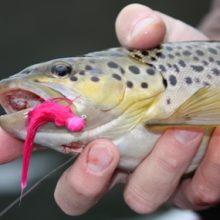This article may contain affiliate links. If you make a purchase after clicking on a link we may earn a small commission at no extra cost to you. As an Amazon Associate, I earn from qualifying purchases.
Trout Jigs – Tips and Tricks

Fishing a trout jig is a little different than working a spinner or trolling with a large crankbait.
Jigs require a little bit more finesse and for you to be able to feel what is going on as you work the jig to give it a more life like action.
In this article we’ll concentrate on using jigs on smaller streams and rivers as it is very different using a jig for lake trout.
Jigs are generally considered an imitator type lure. In other words they are designed to look and move a lot like the types of food that trout will naturally feed on, such as:
- Insect larvae
- Nymphs
- Leeches
- Crustaceans
Because of this, how you fish them is a little different to fishing with a spinner or spoon. Jigs need a little bit action to mimic the short erratic movements that small insects make as they are carried downstream by the river current.
Trout Jigs
Trout jigs traditionally were made from natural hair and fibers. However, a lot of modern jigs are made from artificial plastics.
One thing that a lot of jigs for trout have in common is a weighted head. The head is usually made from lead and helps the jig move a bit more naturally. If also helps with casting. Without the added weight you would struggle to cast them any great distance.
1. Marabou Jigs
Marabou jigs have been around for over a century. They are very similar to a wet fly that imitates a young sub-aquatic insect. Most will have a dyed marabou tail and some form of dressed body on the hook.
The dressed body can be made from chenille and or other dyed furs. And they may also have a hackle that is would down the body towards the tail.
Many patterns will have a weighted head. The weight adds extra life to the jig as it moves through the water.
The head may be cast onto the hook and have the eye set into it a specific angle or they might be just a small copper or lead bead that is threaded up the hook shank towards the eye before the jig has been tied.
2. Soft Plastic Jigs
Soft plastic jigs are usually made from a soft artificial material. They can be threaded onto the hook just like a worm. Some may already come on a hook. There are a few different designs available and will generally have a long tubular body with some form of tail at the end.
The tail will flutter in the water as it moves. They can also be quite complex in their design and may even look to imitate a small minnow or crawdad.
3. Tube Jigs
Tube jigs are pretty basic. They are just one uniform piece of soft plastic that at best will imitate a worm. You can find some that have a sprayed on scent to help attract the trout more. The tail may have a tail with a few slits in it to help create a little movement.
How to Fish a Jig for Trout
The most basic way to fish a jig in a river or stream is to cast it with o added weight on the line. You’ll be relying on the weight of the jig head to help to achieve a decent cast.
With nothing but the jig on the end of your line you will be able to twitch the tip as it moves along with the current. This movement is what will help give a more life like appearance.
You can either let the jig drift down naturally along the bottom or raise your rod tip up and try to keep it suspended off the bottom. Bouncing a jig on the bottom will of course increase the risk of getting snagged.
The other option is to work it under a bobber or float. With this approach you can ensure that the jig never snags on the bottom. You can use the float to set the desired depth at which you want the jig to be suspended at from the river bottom.
The main drawback with using a float with a jig is that you cannot really add a movement to the jig by twitching the rod tip. To do so would make the bloat splash about on the surface, which could in turn spook a wary trout.
Trout Jigging Setup
For super finesse trout jigging you really do need an ultralight spinning setup. If you are not using a float then the sensitivity of the tip in the rod is super important.
The rod needs to be light and have a fast action.
- 6.5 or 7 foot in length
- Fast action with good tip sensitivity
- Preferably made from graphite or a graphite blend
Most spinning rods for trout fishing will fall somewhere into the above ranges. On really small streams you can drop down to a 5.5 foot rod.
The line should be around the 4 lb mark depending on the waters you are fishing of course. On really small streams and creeks you can drop down to 2 lb line. Line this light will really help with casting.
The reel should as ever match the line. A good trout spinning reel will be in the 1000 to 2500 size range.
